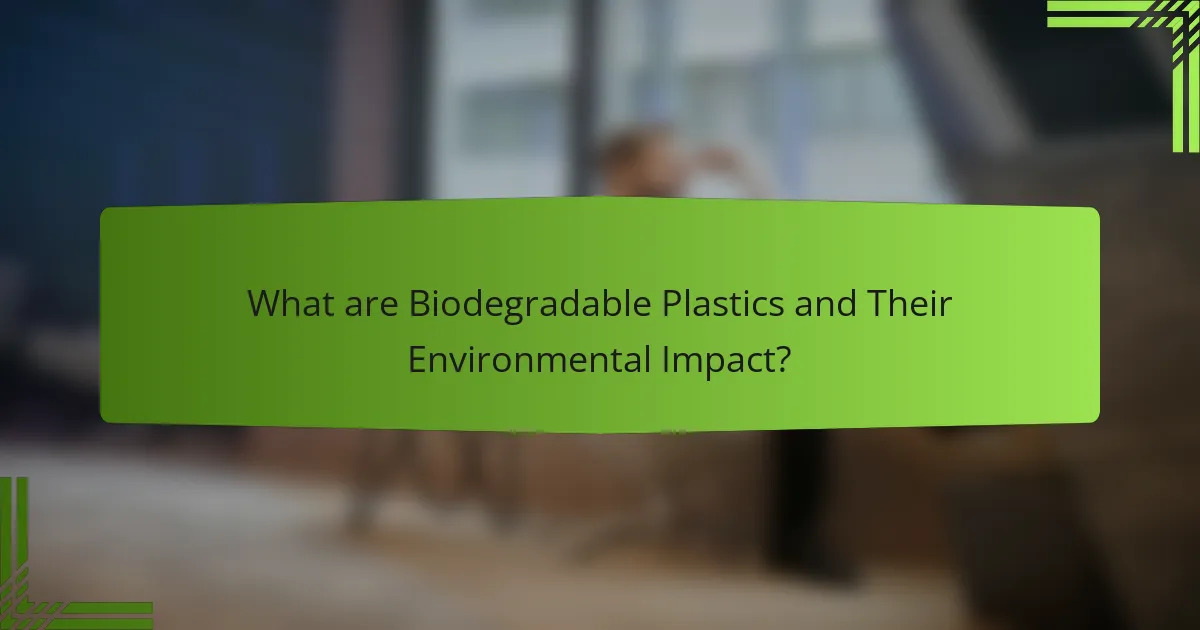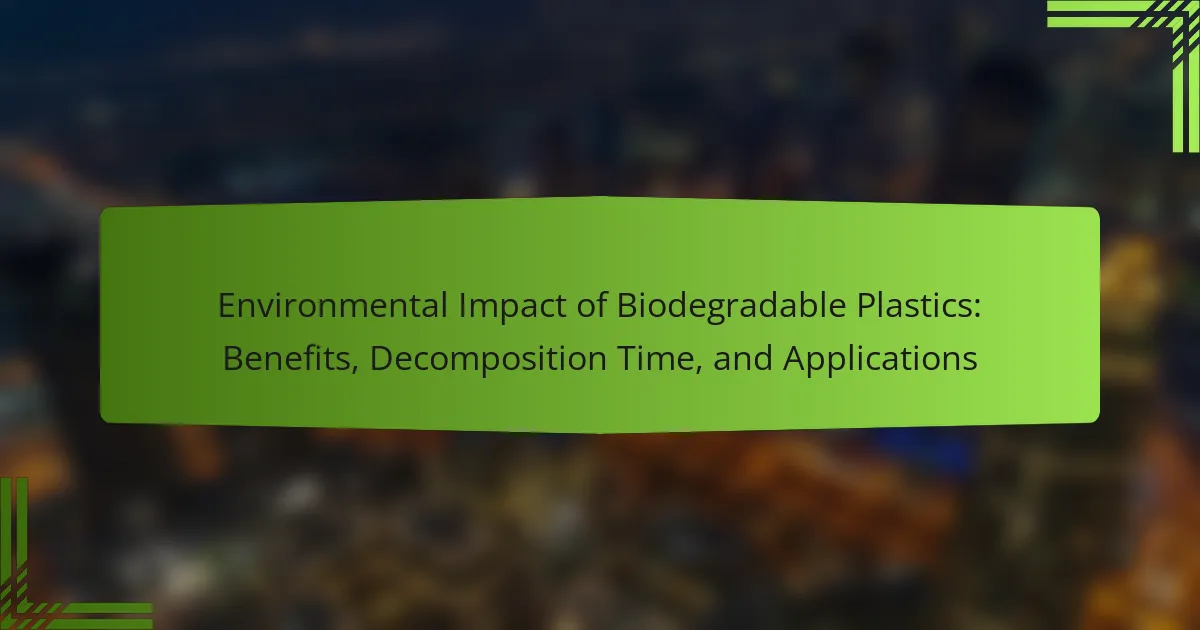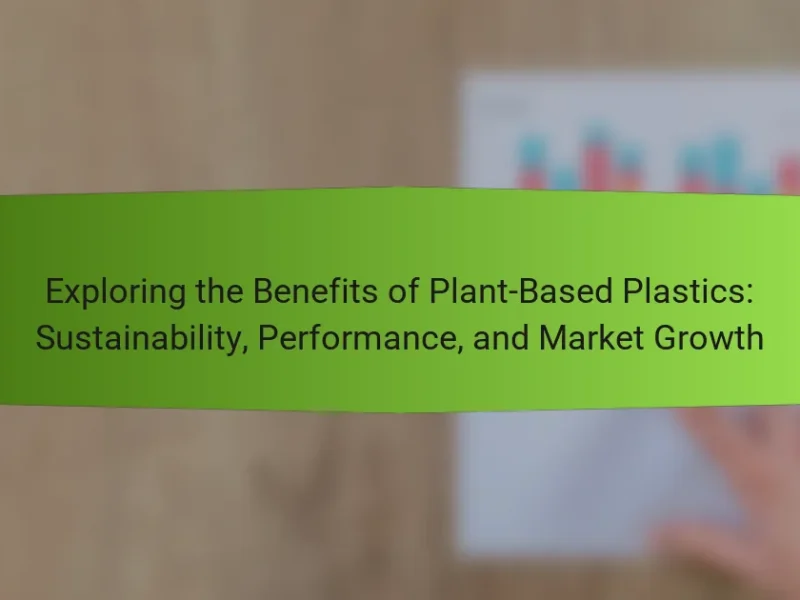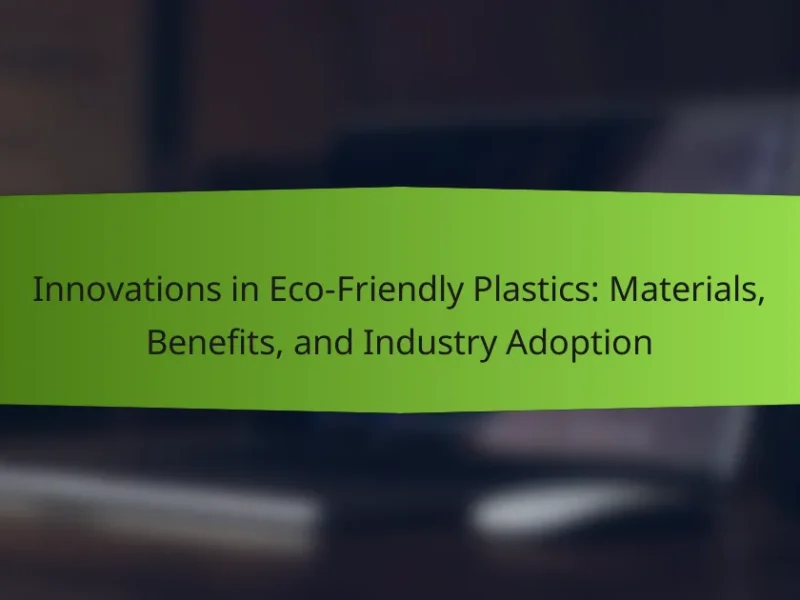Biodegradable plastics are materials engineered to decompose naturally in the environment through the action of microorganisms. This article examines the environmental impact of biodegradable plastics, highlighting their benefits in reducing plastic pollution, landfill waste, and greenhouse gas emissions. It discusses the decomposition time of these materials, which can range from a few months to several years, and emphasizes the importance of proper disposal methods for maximizing their effectiveness. Additionally, the article references studies that demonstrate the potential of biodegradable plastics to decrease carbon footprints and mitigate ocean plastic waste, while also addressing the challenges posed by inappropriate disposal practices.

What are Biodegradable Plastics and Their Environmental Impact?
Biodegradable plastics are materials designed to break down naturally in the environment. They undergo decomposition through the action of living organisms, primarily microorganisms. This process can significantly reduce plastic pollution compared to traditional plastics. Biodegradable plastics can decompose within a few months to a few years, depending on environmental conditions.
Their environmental impact includes reducing landfill waste and decreasing greenhouse gas emissions. Studies show that biodegradable plastics can lower carbon footprints compared to conventional plastics. For instance, a 2018 study published in the journal “Environmental Science & Technology” indicated that biodegradable plastics could reduce plastic waste in oceans. However, their effectiveness depends on proper disposal methods and environmental factors.
Inappropriate disposal can lead to incomplete degradation, negating their benefits. Overall, biodegradable plastics present a promising alternative to traditional plastics, with potential environmental advantages when managed correctly.
How do biodegradable plastics differ from traditional plastics?
Biodegradable plastics differ from traditional plastics in their ability to decompose naturally. Traditional plastics, made from petroleum-based materials, can take hundreds of years to break down. In contrast, biodegradable plastics are designed to break down more quickly through microbial action. They typically decompose within a few months to a couple of years, depending on environmental conditions. This faster decomposition reduces long-term environmental pollution. Biodegradable plastics are often made from renewable resources, such as corn starch or sugarcane, unlike traditional plastics, which rely on fossil fuels. Studies show that biodegradable plastics can significantly reduce landfill waste and greenhouse gas emissions when properly disposed of.
What materials are commonly used to create biodegradable plastics?
Common materials used to create biodegradable plastics include polylactic acid (PLA), starch-based materials, and polyhydroxyalkanoates (PHA). PLA is derived from renewable resources like corn starch or sugarcane. Starch-based biodegradable plastics are made from natural starch sources and can be blended with other materials for improved properties. PHA is produced by microbial fermentation of sugars or lipids, making it fully biodegradable. These materials are chosen for their ability to decompose naturally and reduce environmental impact.
What are the environmental benefits of using biodegradable plastics?
Biodegradable plastics offer significant environmental benefits. They reduce plastic pollution by breaking down into natural substances. This process minimizes the accumulation of plastic waste in landfills and oceans. Biodegradable plastics can decompose in a matter of months to a few years, unlike traditional plastics that can take hundreds of years. This quicker decomposition helps in reducing greenhouse gas emissions during the breakdown process. Moreover, they can be made from renewable resources, decreasing reliance on fossil fuels. Studies indicate that using biodegradable plastics can lead to a reduction in overall environmental impact compared to conventional plastics.
Why is the decomposition time of biodegradable plastics important?
The decomposition time of biodegradable plastics is important because it determines their environmental impact. Shorter decomposition times reduce the accumulation of plastic waste in landfills and oceans. This leads to less harm to wildlife and ecosystems. For instance, biodegradable plastics can break down in months, while conventional plastics can take hundreds of years. The faster they decompose, the sooner they return nutrients to the soil. Additionally, understanding decomposition time helps in waste management strategies. It allows for better planning in recycling and composting efforts. Studies show that biodegradable plastics can significantly lower the carbon footprint compared to traditional plastics.
How long does it typically take for biodegradable plastics to decompose?
Biodegradable plastics typically take three to six months to decompose in optimal conditions. The decomposition time can vary based on environmental factors like temperature, humidity, and the presence of microorganisms. In industrial composting facilities, the process is faster due to controlled conditions. However, in natural environments, it can take longer, sometimes up to several years. Research indicates that the specific type of biodegradable plastic also influences decomposition rates. For instance, polylactic acid (PLA) decomposes more quickly than other types, such as polyhydroxyalkanoates (PHA).
What factors influence the decomposition time of biodegradable plastics?
The decomposition time of biodegradable plastics is influenced by several factors. These factors include the type of material used, environmental conditions, and the presence of microorganisms. Different biodegradable plastics have varying chemical compositions that affect their breakdown rates. For instance, polylactic acid (PLA) decomposes differently than polyhydroxyalkanoates (PHA). Environmental conditions such as temperature, humidity, and exposure to sunlight also play significant roles. Higher temperatures and moisture levels generally accelerate decomposition. Additionally, the presence of microorganisms, including bacteria and fungi, is crucial for breaking down biodegradable plastics. Studies show that plastics in composting environments decompose faster due to the active microbial population.
In what applications are biodegradable plastics most commonly used?
Biodegradable plastics are most commonly used in packaging, agricultural films, and disposable cutlery. In packaging, they reduce plastic waste and enhance sustainability. Agricultural films help in crop protection while being environmentally friendly. Disposable cutlery made from biodegradable materials provides a sustainable alternative to traditional plastics. These applications are driven by the need to reduce environmental impact and promote eco-friendly practices.
What industries are adopting biodegradable plastics?
The packaging industry is adopting biodegradable plastics extensively. This shift is driven by the need for sustainable alternatives to traditional plastic. Food packaging companies are particularly focused on biodegradable options to reduce environmental impact. The agricultural sector is also utilizing biodegradable plastics for mulch films and plant pots. Retailers are increasingly using biodegradable bags to align with consumer preferences for eco-friendly products. The textile industry is exploring biodegradable materials for clothing and accessories. Additionally, the medical industry is incorporating biodegradable plastics in disposable items to enhance waste management. These trends indicate a growing commitment across various sectors to adopt biodegradable plastics for environmental sustainability.
How are biodegradable plastics being utilized in everyday products?
Biodegradable plastics are utilized in everyday products such as packaging, utensils, and bags. These materials break down more quickly than traditional plastics. They are often made from renewable resources like cornstarch or sugarcane. In packaging, biodegradable plastics reduce landfill waste and environmental impact. For utensils, they provide a sustainable alternative to single-use plastic items. Biodegradable bags help decrease plastic pollution in oceans and landfills. Many companies are adopting these materials to meet consumer demand for eco-friendly options. Research indicates that biodegradable plastics can decompose in industrial composting facilities within months. This contrasts with conventional plastics, which can take hundreds of years to break down.
What challenges do biodegradable plastics face in the market?
Biodegradable plastics face several challenges in the market. One major challenge is the higher production costs compared to conventional plastics. This can deter manufacturers from adopting biodegradable options. Additionally, there is often a lack of infrastructure for proper disposal and composting. Many biodegradable plastics require specific conditions to decompose effectively, which are not widely available. Consumer awareness and education also pose challenges. Many consumers are unaware of the differences between biodegradable and traditional plastics. Furthermore, performance issues can arise, as some biodegradable plastics may not meet the durability standards of conventional plastics. Regulatory uncertainties can also create barriers, as inconsistent policies affect market stability. Lastly, competition from cheaper, non-biodegradable alternatives remains a significant hurdle for biodegradable plastics.
What misconceptions exist regarding biodegradable plastics?
Biodegradable plastics are often misunderstood. One common misconception is that they decompose quickly in landfills. In reality, biodegradable plastics require specific conditions to break down, such as exposure to moisture and microorganisms. Without these conditions, they can take years to decompose, similar to traditional plastics. Another misconception is that all biodegradable plastics are environmentally friendly. Some contain harmful additives that can release toxins during decomposition. Additionally, many people believe that biodegradable plastics can be composted in home compost piles. However, most require industrial composting facilities to degrade effectively. Lastly, there is a belief that biodegradable plastics solve the plastic pollution problem entirely. While they can reduce some plastic waste, they are not a complete solution and still contribute to environmental issues if not disposed of properly.
How do regulatory policies impact the use of biodegradable plastics?
Regulatory policies significantly influence the use of biodegradable plastics. These policies can establish standards for production, labeling, and disposal. Compliance with regulations often dictates the market viability of biodegradable options. For example, the European Union has implemented directives that promote biodegradable materials. Such regulations encourage manufacturers to invest in sustainable alternatives. Additionally, policies can provide financial incentives for companies adopting biodegradable plastics. Conversely, strict regulations may limit the development and use of certain biodegradable products. Overall, regulatory frameworks play a crucial role in shaping the biodegradable plastics market.
What are the future prospects for biodegradable plastics?
The future prospects for biodegradable plastics are promising due to increasing environmental concerns. Biodegradable plastics are designed to decompose more quickly than traditional plastics. This feature addresses pollution and waste management issues. The global biodegradable plastics market is projected to grow significantly. According to a report by ResearchAndMarkets, the market is expected to reach $6.9 billion by 2027. Innovations in materials science are leading to better performance and lower production costs. Additionally, government regulations are increasingly favoring sustainable alternatives. This trend encourages manufacturers to invest in biodegradable options. Consumer demand for eco-friendly products is also rising. These factors collectively indicate a positive future for biodegradable plastics.
How can innovations in technology improve biodegradable plastics?
Innovations in technology can enhance biodegradable plastics by improving their decomposition rates and overall performance. Advanced materials science enables the development of new biopolymers that break down more rapidly in various environments. For instance, research shows that incorporating natural additives can accelerate the degradation process. Technologies like 3D printing allow for customized biodegradable products that minimize waste. Additionally, improved manufacturing techniques can reduce the energy consumption associated with producing biodegradable plastics. Innovations in nanotechnology can also enhance the mechanical properties of these materials. This results in stronger, more durable biodegradable options. Overall, technological advancements lead to more efficient and effective biodegradable plastics, addressing environmental concerns more effectively.
What role do consumers play in the adoption of biodegradable plastics?
Consumers play a crucial role in the adoption of biodegradable plastics. Their purchasing decisions drive demand for eco-friendly products. Increased consumer awareness of environmental issues influences manufacturers to develop biodegradable options. Surveys indicate that 62% of consumers prefer sustainable packaging. This preference encourages brands to invest in biodegradable materials. Additionally, consumer advocacy can lead to policy changes supporting biodegradable plastic use. Social media campaigns raise awareness and educate the public on the benefits of biodegradable plastics. Ultimately, consumer behavior shapes market trends and impacts production practices in the industry.
How can individuals contribute to the reduction of plastic waste?
Individuals can contribute to the reduction of plastic waste by adopting sustainable practices. They can reduce single-use plastics by using reusable bags, bottles, and containers. Switching to biodegradable products also helps minimize plastic pollution. Participating in local clean-up events removes plastic waste from natural environments. Educating others about the impact of plastic waste promotes collective action. Supporting policies aimed at reducing plastic production can drive systemic change. Recycling properly ensures that plastic materials are processed and reused effectively. These actions collectively contribute to a significant decrease in plastic waste.
What practical steps can consumers take to support biodegradable plastics?
Consumers can support biodegradable plastics by choosing products made from these materials. They should look for certifications indicating biodegradability, such as ASTM D6400 or EN 13432. Purchasing items packaged in biodegradable plastics reduces reliance on conventional plastics. Proper disposal is crucial; consumers should compost biodegradable plastics if local facilities are available. Educating others about the benefits of biodegradable options promotes wider acceptance. Supporting brands committed to sustainable practices encourages more companies to adopt biodegradable materials. Participating in local clean-up efforts helps reduce plastic pollution overall. Engaging in advocacy for policies supporting biodegradable plastics can also drive systemic change.
How can businesses promote the use of biodegradable plastics effectively?
Businesses can promote the use of biodegradable plastics effectively by implementing educational campaigns. These campaigns should inform consumers about the environmental benefits of biodegradable plastics. Highlighting their ability to reduce landfill waste is crucial. Businesses can also showcase product certifications that validate biodegradability. Collaborating with environmental organizations can enhance credibility. Offering incentives, such as discounts for using biodegradable products, can encourage consumer adoption. Furthermore, incorporating biodegradable plastics into product lines can demonstrate commitment to sustainability. Research indicates that 73% of consumers prefer brands that promote eco-friendly practices.
Biodegradable plastics are materials designed to decompose naturally in the environment, significantly reducing plastic pollution compared to traditional plastics. This article explores their environmental impact, including benefits such as reduced landfill waste and greenhouse gas emissions, and examines the decomposition time and factors influencing it. Additionally, it discusses common materials used in biodegradable plastics, their applications across various industries, challenges faced in the market, and the role of consumers and businesses in promoting their use. The future prospects for biodegradable plastics are also highlighted, emphasizing the importance of innovation and regulatory support in driving adoption.


